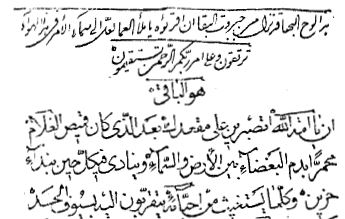
Commencement of the Lawh-i Baha' in INBMC 35
Lawh-i Baha'
(The Surah of Baha' - Resplendent Glory (c. 1865-6? )
Stephen Lambden UC Merced - last updated 01-12-2021
Introduction
Stephen Lambden
The Lawh-i Baha' (The Surah of Baha' = Glory-Splendour dates to around the early (January, 1866 CE) or middle of the Edirne or Adrianople period (c. 1865-6? ), just before the `Most Great Separation' beween Mirza Yahya and Baha'u'llah. Ishraq Khavari, however, dates the Lawh-i Baha' to around the time of the exile from Baghdad to Constantinople-Istanbul (Ganj No. 18). This Tablet commences in Arabic but also has a following Persian section. It was addressed to Khatun Jan Qazviniyya, the daughter of Hajji Asad-Allah Farhadi Qazvini (see Mazandarani, Athar al-asrar, II:89-90).
The Lawh-i Baha' commences with the following introductory prelude,
This is the Lawh al-Baha' which was revealed from the Empyrean of Eternity (jabarut al-baqa'). So recite it then!, O concourse of the Theophanic Cloud (mala' al-`ama'), perchance ye might soar up unto the heaven of the Cause of God (sama' al-amr) in this atmosphere, and thus be firmly established within the Cause of thy Lord, the All-Merciful.
The huwa ("He is") formula is then set forth: "He is the All-Eternal" (huwa al-baqi [baqa]).
Then the female figure Khatum Jan is addressed as follows:
O Maidservant of God (amat-Allah)!
Be patient under all circumstances and mindful of the fact that the robe of this Youth (qamis al-ghulam) was dyed crimson with the blood of enmity betwixt earth and heaven. At every moment he crieth out with a soul-saddending cry (bi-nida' hazin). All of his associates that have attempted to succour him found themselves assailed by the swords of emnity (suyuf al-hasad)....
Mss. and printed editions of this scriptural Tablet can be located, for example, in
- INBMC 35: 70-81.
Some attention has been paid to this scriptural Tablet by `Abd al-Hamid Ishtraq Khavari in his Ganj-i shayigan and Adib Taherzadeh in his The Revelation of Baha'u'llah (vol. 2:171-60).



